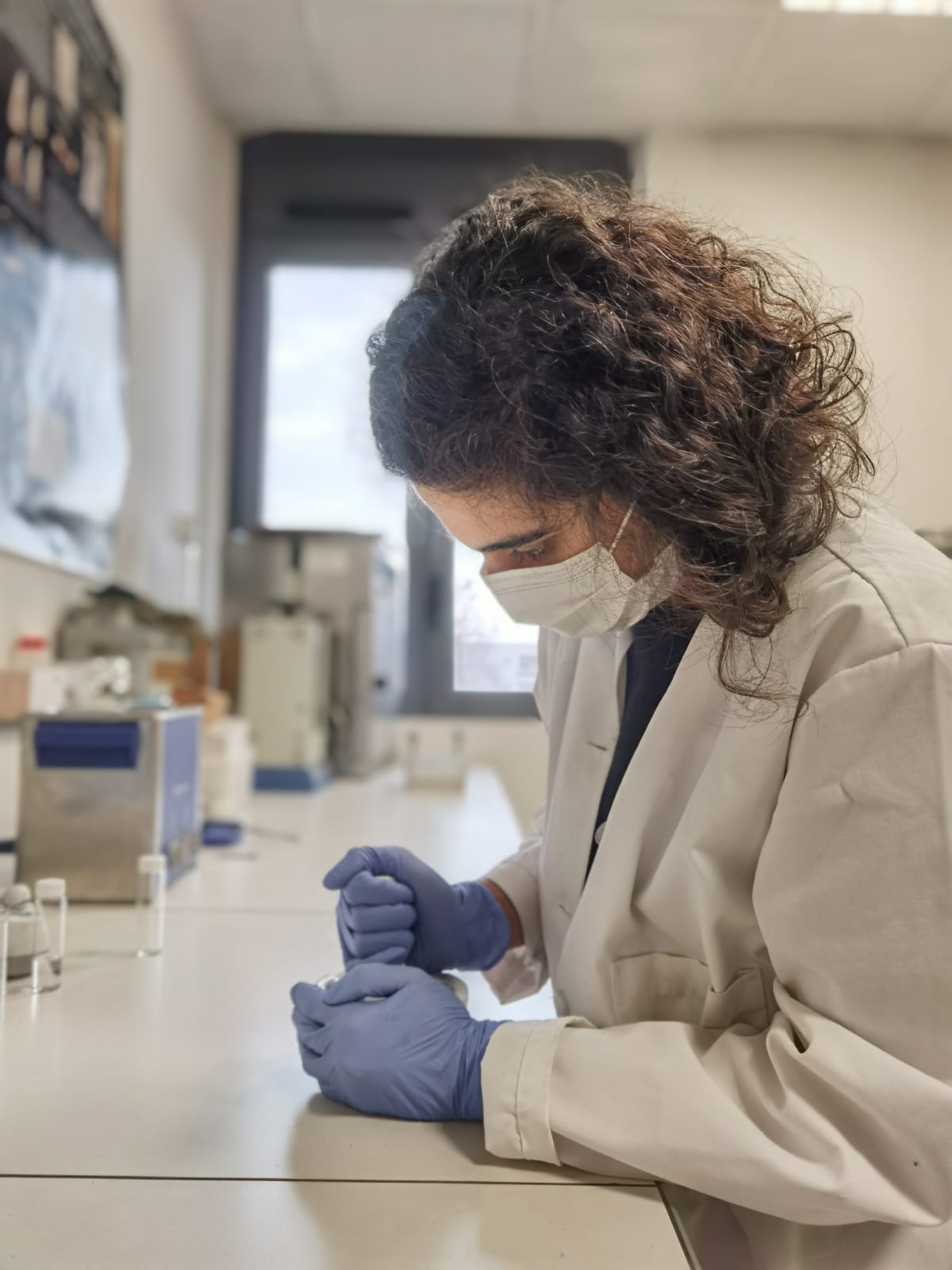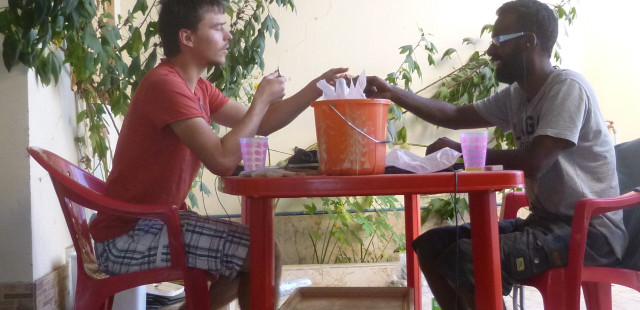Prehistoric communities in south-eastern Arabia appear to not have used pottery in domestic settings until c. 2500 BC, despite having knowledge of complex pyrotechnologies and being in contact with ceramic-producing groups (Azzarà, 2009; Méry, 2000; Thornton and Ghazal, 2016). By c. 2500 BC, or the middle Umm an-Nar period, pottery production was rapidly and widely adopted, coinciding with new burial practices, the establishment of semi-sedentary settlements and oasis agriculture. The adoption of pottery in the Umm an-Nar period has been linked to new modes of food preparation and consumption (Thornton and Ghazal 2016), however, scientific studies of pottery have primarily focused on determining the geological/geographical source of different types of pottery and their production technology (e.g. Méry, 2000), and not investigated their role in subsistence or culinary practices.
This research focused on investigating the contents of Early Bronze Age pottery from inland and coastal sites in south-eastern Arabia using lipid residue analysis. Pottery produced locally at the site-level as well as regionally-produced pottery was analysed to explore the links between ceramic technology, subsistence practices and sedentism as ceramic production was widely adopted in the region. The contents of imported pottery from Mesopotamia and the Indus Civilisation from inland and coastal sites were also studied to detect organic products that may have been transported as part of long-distance exchange.
Lipids were extracted from 178 pottery fragments (imported, regionally-produced and locally-produced pottery) from the sites of Hili 8, Hili North Tomb A, Bat, Salūt-ST1, Mukthru (inland), Dahwa 7 (al-Batinah), Suwayh 3 and Kalba 4 (coastal). Most of these sites have associated mudbrick towers and/or settlement, and at some sites, there is evidence of the presence of a large amount of imported pottery and other objects, such as at Salūt-ST1 (Frenez et al., 2016; Méry et al., 2017), Dahwa 7 (Douglas et al., 2021) and Kalba 4 (Eddisford, 2022). Lipid extracts were analysed via gas chromatography-mass spectrometry (GC-MS) to separate and identify different organic compounds linked to vessel usage (Evershed et al., 1990). A subset of the extracts were analysed via gas-chromatography-combustion-isotope ratio mass spectrometry (GC-C-IRMS) to distinguish the source of the animal fats present in the vessels (Dudd and Evershed, 1998) thanks to funding from the Main Research Grant, IASA. The results indicate the presence of terrestrial animal products in a majority of vessels, in both imported vessels (such as from Mesopotamia), and locally-produced vessels. Profiles of plant oils were detected in two imported Indus Black-Slipped Jars from Hili 8, as well as from Fine Red Omani jars, that were regionally produced, from Hili North Tomb A (Suryanarayan et al. 2022). Plant oils were also detected in vessels from Kalba 4, as well as from Umm an-Nar and Iron Age vessels from Bat (Suryanarayan et al. in prep.); and plant products were detected in two vessels from Salūt-ST1 (Suryanarayan et al. 2024).
The results are indicative of broader patterns related to Early Bronze Age subsistence and long distance exchange. The results highlight the importance of ruminant animal fats such as meat and dairy products, suggesting the continued and vital role of the pastoral economy, as well as possibly that of hunting, for subsistence at different sites across south-eastern Arabia during the Early Bronze Age (Suryanarayan et al. in prep). This is an important find, as several sites have extremely poor preservation of animal bones, and thus the lipid residues serve as a proxy for the missing animal remains and also provide insight into animal management strategies. The detection of plant oils in imported and regionally-produced vessels may suggest the movement of plant oils through exchange networks. However, imported vessels appear to have contained different types of products, such dairy products, ruminant carcass fats, non-ruminant fats as well as marine products, possibly reflecting multi-purpose usage over their use-life (Suryanarayan et al., 2024; Suryanarayan et al. in prep).
The direct detection of organic products in Early Bronze Age pottery demonstrates the value of applying biomolecular methods for examining connections between material culture and dietary practices in the archaeology of Arabia. Combined with other bioarchaeological approaches, such methods can facilitate an exciting new understanding about ancient foodways, culinary practice and vessel use in the region.
Akshyeta Suryanarayan, grant recipient 2020.
References
Azzarà, V. M. (2009). Domestic architecture at the Early Bronze Age sites HD–6 and RJ–2, Ja’alān, Sultanate of Oman. Proceedings of the Seminar for Arabian Studies 39: 1–16.
Douglas, K. al-Jahwari, N. S., Méry, S, Hesein, M. Willians, K. D. (2021). Umm an-Nar settlement pottery from Dahwa 7 (DH7), northern al-Batinah, Oman. Arabian Archaeology and Epigraphy 32, 198-212.
Dudd S. N. & Evershed R. P. (1998). Direct demonstration of milk as an element of archaeological economies. Science, 282, 1478–1481.
Eddisford, D. (2022). Exchange networks of the Early Bronze Age Gulf: The imported ceramics from Kalba 4 (United Arab Emirates). Arabian Archaeology and Epigraphy 33, 1, 198-212.
Evershed, R. P., Heron, C., & Goad, L. J. (1990). Analysis of organic residues of archaeological origin by high-temperature gas chromatography and gas chromatography-mass spectrometry. Analyst, 115, 1339–1342.
Frenez, D., Degli Esposti, M., Méry, S., & Kenoyer, J. M. (2016). Bronze age Salut (ST1) and the Indus civilization: Recent discoveries and new insights on regional interaction. Proceedings of the Seminar for Arabian Studies, 46, 107–124.
Méry S. (2000). Les céramiques d’Oman et l’Asie moyenne: Une archéologie des échanges à l’Age du Bronze. CNRS.
Méry, S., Degli Esposti, M., Frenez, D., & Kenoyer, J. M. (2017). Indus potters in central Oman in the second half of the third millennium BC. First results of a technological and archaeometric study. Proceedings of the Seminar for Arabian Studies, 47, 163–183.
Suryanarayan, A., Méry, S., Mazuy, A., & Regert, M. (2022). Foodstuffs and organic products in ancient SE Arabia: Preliminary results of ceramic lipid residue analysis of vessels from Hili 8 and Hili North Tomb A, al Ain, United Arab Emirates. Proceedings of the Seminar of Arabian Studies, 54, 379–401.
Suryanarayan, A., Degli Esposti, M., Méry, S., Strolin, L., Mazuy, A., Moraleda Cibrián, N., Villanueva, J. & Regert, M. (2024). Domestic food practice and vessel-use at Salūt-ST1, central Oman, during the Umm an-Nar period. Arabian Archaeology and Epigraphy. https://doi.org/10.1111/aae.12247
Thornton C. P., & Ghazal R. O. (2016). Typological and chronological consideration of the ceramics at Bat, Oman. In C. P Thornton, C. M. Cable, & G. L. Possehl (Eds.), The Bronze Age towers at Bat, Sultanate of Oman: Research by the Bat Archaeological Project 2007–12. (pp. 179–216) University of Pennsylvania Museum of Archaeology and Anthropology.




